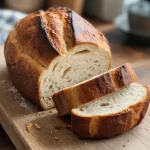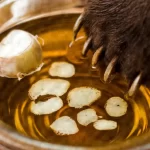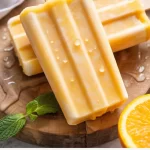This homemade strawberry jam recipe is my go-to because it transforms fresh, juicy strawberries into a delightful spread that’s bursting with natural sweetness and an irresistible hint of lemon. Making it from scratch is super satisfying, and there’s nothing quite like topping my morning toast with a jam that tastes like summer in a jar!

Nothing beats the satisfying feeling of preparing your own homemade strawberry jam. I especially love using strawberries fresh from the field, perfectly mashed with the right amount of granulated sugar and a dash of lemon juice for just the right amount of tartness.
Not for the faint of heart or the short of time, making jam instead of enjoying ready-to-spread preserves takes some serious commitment. But the reward is well worth it.
You’re going to love this one.
Ingredients

Fresh Strawberries:
High in antioxidants, vitamins, and fiber; inherently sweet.
Granulated Sugar:
Sweetness key; serves as a preservative.
Lemon Juice:
Contributes to the taste; assists in setting the jam with acid.
Fruit Pectin (Optional):
Concentrates the product; hastens gelling.
Ingredient Quantities
“`html
- 2 pounds fresh strawberries, hulled and mashed
- 4 cups granulated sugar
- 1/4 cup lemon juice
- 1 packet fruit pectin (optional)
“`
Instructions
1. Start by washing the strawberries very well in cold water. When they have been cleaned, trim and hull the strawberries, taking off the leafy parts on top.
2. Put the hulled strawberries in a large bowl and use a potato masher or fork to achieve your desired consistency.
3. In a saucepan with a sturdy bottom, combine the strawberries, which have been mashed, with the sugar, which is granulated.
4. In the saucepan, combine the lemon juice with the strawberries and sugar mixture.
5. Put the saucepan on medium heat and stir the mixture until the sugar fully dissolves and the mixture begins to reach a simmer.
6. If employing fruit pectin, add it in accordance with the directions on the package, and make sure to stir it in very well to ensure it is fully incorporated.
7. The mixture should be brought to a rapid boil, at which point it should be allowed to continue boiling for about 1 minute. During this time, it is essential to stir constantly to prevent the mixture from sticking to the bottom of the pan or burning.
8. To ensure the right consistency, put a small plate in the freezer for a few minutes. Then, take a small ladle of the hot jam and drop it onto the plate. Allow it to sit for a minute and then run your finger through it; if the jam wrinkles and holds the shape of your finger, it’s ready to come off the heat.
9. When the jam has attained the desired thickness, take it off the heat, and carefully remove any foam that may have formed.
10. With care, pour the hot jam into sterilized jars, ensuring that there is approximately a 1/4-inch space between the jam and the top of the jar. Seal the jars with lids and process them in a boiling water bath for 10 minutes. Alternatively, let the jars cool to room temperature, seal them, and refrigerate the jam for use that doesn’t require jar preservation.
Equipment Needed
1. Colander
2. Paring knife
3. Large bowl
4. Potato masher or fork
5. Saucepan with a sturdy bottom
6. Wooden spoon or heat-resistant spatula
7. Small plate (for testing jam consistency)
8. Ladle
9. Sterilized jars with lids
10. Large pot (for boiling water bath, if using)
11. Jar lifter or tongs (for handling hot jars)
FAQ
- Q: Can I use frozen strawberries instead of fresh?You can use frozen strawberries, yes. Just be certain to thaw and drain them before incorporating them into your dish.
- Q: Is the fruit pectin necessary?The optional fruit pectin helps the jam set, but if you prefer an even looser consistency, it is not an essential ingredient.
- Q: How long can I store the strawberry jam?The jam made from strawberries can be stored in containers that have been sterilized and can last for as long as one year if they are sealed properly and airtight.
- Q: Can I reduce the amount of sugar? A: Yes, but reducing sugar may affect the shelf life and setting of the jam. Adjust to taste with caution.
- Q: How should I sterilize the jars?Boil the jars in water for 10 minutes or use a dishwasher’s sterilize setting to make sure they’re free from microbes.
- Q: Can lemon juice be substituted?Lemon juice adds acidity, which aids in setting and preserving the jam. If necessary, you can substitute it with lime juice.
Substitutions and Variations
Two pounds of fresh strawberries, hulled and mashed
Two pounds of frozen strawberries, thawed
2 pounds berries (like raspberries or blackberries), mixed, hulled, and mashed
4 cups of sugar, in granulated form
Four cups of sugar made from cane.
Honey or agave syrup, 3 1/2 cups
1/4 cup of lemon juice
1/4 cup juice from limes
1/4 cup orange juice
1 packet of fruit pectin (optional)
3 tablespoons pectin, powdered
The juice from a single green apple (to supply natural pectin)
Pro Tips
1. Maceration for Enhanced Flavor Allow the strawberries and sugar to sit together for about 30 minutes to an hour before cooking. This maceration draws out the juices and helps the sugar dissolve, enhancing the flavor profile of the jam.
2. Adjusting Pectin Use If using fruit pectin, consider using less sugar, or choose a low-sugar pectin to ensure the jam thickens without relying on excessive sweetness. This approach can result in a more fruit-forward jam.
3. Skim the Foam To ensure your jam has a clear appearance and smooth texture, remove any foam that forms on the surface while boiling. This step helps in creating a more professional finish to your jam.
4. Temperature Check Use a candy thermometer to ensure your jam reaches the setting point of about 220°F (104°C). This step provides an additional assurance alongside the wrinkle test to achieve the perfect consistency.
5. Storage Tip Store the sterilized jars upside down for the first 12-24 hours after sealing them. This can help create a better seal, ensuring your jam stays preserved longer.

Strawberry Jam Recipe
My favorite Strawberry Jam Recipe
Equipment Needed:
1. Colander
2. Paring knife
3. Large bowl
4. Potato masher or fork
5. Saucepan with a sturdy bottom
6. Wooden spoon or heat-resistant spatula
7. Small plate (for testing jam consistency)
8. Ladle
9. Sterilized jars with lids
10. Large pot (for boiling water bath, if using)
11. Jar lifter or tongs (for handling hot jars)
Ingredients:
“`html
- 2 pounds fresh strawberries, hulled and mashed
- 4 cups granulated sugar
- 1/4 cup lemon juice
- 1 packet fruit pectin (optional)
“`
Instructions:
1. Start by washing the strawberries very well in cold water. When they have been cleaned, trim and hull the strawberries, taking off the leafy parts on top.
2. Put the hulled strawberries in a large bowl and use a potato masher or fork to achieve your desired consistency.
3. In a saucepan with a sturdy bottom, combine the strawberries, which have been mashed, with the sugar, which is granulated.
4. In the saucepan, combine the lemon juice with the strawberries and sugar mixture.
5. Put the saucepan on medium heat and stir the mixture until the sugar fully dissolves and the mixture begins to reach a simmer.
6. If employing fruit pectin, add it in accordance with the directions on the package, and make sure to stir it in very well to ensure it is fully incorporated.
7. The mixture should be brought to a rapid boil, at which point it should be allowed to continue boiling for about 1 minute. During this time, it is essential to stir constantly to prevent the mixture from sticking to the bottom of the pan or burning.
8. To ensure the right consistency, put a small plate in the freezer for a few minutes. Then, take a small ladle of the hot jam and drop it onto the plate. Allow it to sit for a minute and then run your finger through it; if the jam wrinkles and holds the shape of your finger, it’s ready to come off the heat.
9. When the jam has attained the desired thickness, take it off the heat, and carefully remove any foam that may have formed.
10. With care, pour the hot jam into sterilized jars, ensuring that there is approximately a 1/4-inch space between the jam and the top of the jar. Seal the jars with lids and process them in a boiling water bath for 10 minutes. Alternatively, let the jars cool to room temperature, seal them, and refrigerate the jam for use that doesn’t require jar preservation.
















